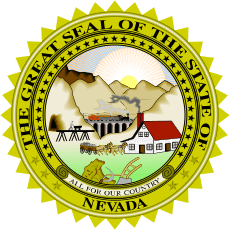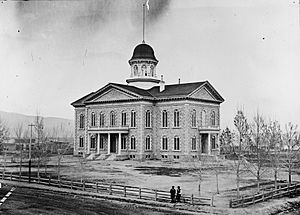Nevada Legislature facts for kids
Quick facts for kids Nevada Legislature |
|
|---|---|
| 80th Nevada Legislature | |
 |
|
| Type | |
| Type | |
| Houses | Senate Assembly |
|
Term limits
|
Senate: 3 terms (12 years) Assembly: 6 terms (12 years) |
| History | |
|
New session started
|
February 4, 2019 |
| Leadership | |
|
President of the Senate
(Lt. Governor) |
Lisa Cano Burkhead (D)
Since December 16, 2021 |
|
President pro tempore of the Senate
|
Moises Denis (D)
Since November 9, 2016 |
|
Speaker of the Assembly
|
Jason Frierson (D)
Since February 6, 2017 |
| Structure | |
| Seats | 63
|
 |
|
|
Senate political groups
|
|
 |
|
|
Assembly political groups
|
|
|
Length of term
|
Senate: 4 years Assembly: 2 years |
| Salary | $150.71/day + per diem |
| Elections | |
|
Senate last election
|
November 3, 2020 (11 seats) |
|
Assembly last election
|
November 3, 2020 |
|
Senate next election
|
November 8, 2022 (10 seats) |
|
Assembly next election
|
November 8, 2022 |
| Redistricting | Legislative control |
| Meeting place | |
 |
|
| Nevada Legislative Building, Carson City | |
| Website | |
| Nevada Legislature | |
The Nevada Legislature is the law-making group for the state of Nevada. It has two main parts: the Assembly (the lower house) with 42 members, and the Senate (the upper house) with 21 members. This means there are 63 members in total.
The Nevada Legislature is one of the smallest state legislatures in the United States. Only Alaska and Delaware have fewer members. As of 2019, the Nevada State Legislature was the first state legislature in U.S. history where most of its members were women. Since 2021, the Democratic Party has been in charge of both parts of the Nevada State Legislature.
Contents
How the Nevada Legislature Started
The Nevada Legislature began when the Nevada Territory was created in 1861. In its very first meeting, it set up the nine original counties of Nevada. This meeting happened outside Carson City.
Nevada became a state in 1864 under its own Nevada Constitution. This constitution gives the power to make laws to the Senate and Assembly. These two groups together are called "The Legislature of the State of Nevada".
The Legislature decides how many Senators and Assembly members there will be. It also draws the lines for their districts after each census (which happens every ten years). However, there can't be more than 75 lawmakers in total. The number of Senators is also linked to the Assembly's size. The constitution says the Senate must have at least one-third and no more than half the number of members as the Assembly.
After the 2010 U.S. Census, the Legislature tried to pass new district maps. But the governor said no (vetoed them). The Legislature couldn't get enough votes to overrule his decision. So, a state court had to decide what the new districts would be. Since then, each Senate district is made up of two nearby Assembly districts.
How Long Lawmakers Serve
Members of the Assembly are elected for two years. They can serve a maximum of six terms, which is 12 years in total. Senators are elected for four years. They can serve a maximum of three terms, also 12 years. These limits on how long someone can serve were added to the Nevada Constitution in 1996 after voters approved them.
When the Legislature Meets and Who Can Join
The Legislature officially starts its work on the first Monday of February after an election. Meetings happen every two years, in odd-numbered years. Nevada is one of only four states that meet every two years. The others are Montana, North Dakota, and Texas.
Regular meetings of the Legislature must end within 120 days. This means they must finish by midnight Pacific Daylight Time (PDT) on the 120th day. If they do anything after this time, it's not valid. The only exception is if the Governor of Nevada calls a special meeting. The governor must also give the Legislature the state budget plan at least 14 days before each regular meeting starts.
To become a member of either the Senate or the Assembly, a person must be a U.S. citizen. They must be at least 21 years old. They also need to have lived in Nevada for one year. Finally, they must be a registered voter in the district they want to represent.
Committees That Help Make Laws
Committees are smaller groups of lawmakers. They study bills (ideas for new laws) in detail before the whole Legislature votes on them. This helps them do their work more efficiently.
- Nevada Assembly Committees:
- Commerce and Labor
- Energy
- Committee of the Whole
- Corrections, Parole, and Probation
- Education
- Government Action
- Health and Human Services
- Judiciary
- Legislative Operations and Elections
- Natural Resources, Agriculture, and Mining
- Taxation
- Transportation
- Ways and Means
- Audit
- General Government
- Human Services
- K-12/Higher Education/CIP
- Public Safety, Natural Resources, and Transportation
- Commerce and Labor
- Nevada Senate Committees:
- Commerce, Labor, and Energy
- Energy
- Committee of the Whole
- Finance
- Audit
- General Government
- Human Services
- K-12/Higher Education/CIP
- Public Safety, Natural Resources, and Transportation
- Government Affairs
- Health and Human Services
- Judiciary
- Legislative Operations and Elections
- Natural Resources
- Revenue and Economic Development
- Senate Parliamentary Rules and Procedures
- Transportation
- Commerce, Labor, and Energy
Where Lawmakers Meet
For seven years after Nevada became a U.S. state in 1864, the Legislature didn't have a permanent place to meet. In 1869, lawmakers passed a law to build a capitol building. Governor Henry G. Blasdel signed it, and $100,000 was set aside for construction.
Work on the Italianate-style building began in 1870. It was designed by Joseph Gosling. The Legislature started meeting in the unfinished building the next year. The building was fully completed by the middle of that year.
The Legislature met in this state capitol building until 1971. Then, both the Senate and Assembly moved to a new Legislative Building. This new building was built just south of the old capitol. The old state capitol building is now used for the governor's office and other state leaders. The old Assembly and Senate rooms are now museums. They can also be used for meetings.
Important Moments in History
Sadie Hurst (1857–1952) was a very important person in Nevada's history. She was the first woman ever elected to the Nevada Legislature. She was a Republican from Washoe County and was elected in 1918.
On February 7, 1920, the Legislature met for a special session. They were there to approve the Federal Suffrage Amendment. This amendment gave women the right to vote across the country. It was Sadie Hurst, the assemblywoman from Reno, who presented the resolution to approve it. She also has the special honor of being the first woman to lead a state Legislature during the approval of this important amendment.
The 80th Nevada Legislature, which met in 2019, was the first state legislature in U.S. history where most members were women. Before this, two other states had a majority of women in just one part of their legislature, but not both.
See also
 In Spanish: Legislatura de Nevada para niños
In Spanish: Legislatura de Nevada para niños



